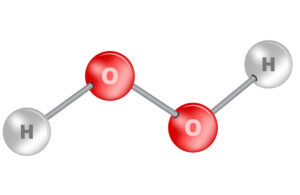
A molecular model of hydrogen peroxide (H2O2) [Illustration by petrroudny via Adobe Stock]
Vaporized hydrogen peroxide (VHP) is the latest medical device sterilization alternative to ethylene oxide (EtO) as the industry seeks to limit potential harm from EtO and increase total sterilization capacity.
Vaporized hydrogen peroxide (also referred to as VH₂O₂) is the FDA’s newest addition to its list of Established Category A sterilization methods for medical devices. Other Category A sterilization methods include EtO, dry heat, moist heat and radiation.
Like the aqueous form of hydrogen peroxide (H₂O₂), VHP (also referred to as VH₂O₂) kills infection-causing bacteria, viruses and all other microbial life by oxidizing amino acids and proteins.
VHP has a similar effectiveness as EtO, which is the most commonly used method for medical device sterilization. Like EtO, VHP can permeate many materials used for medical devices and packaging without causing damage or leaving harmful residue. And VHP can similarly be used to sterilize medical devices in bulk.
But unlike EtO, VHP is not flammable or explosive and is not considered by the EPA to be a cancer risk when inhaled. VHP also sterilizes at lower temperatures than EtO, which reduces the risk of heat damage to device components or materials.
Which medical devices can be sterilized with vaporized hydrogen peroxide?
VHP is an effective sterilization alternative to EtO for many medical devices, including single-use and reusable surgical instruments, endoscopes, implants and devices with electronics, temperature-sensitive devices, combination delivery devices, single-packaged complex devices, and complete assemblies or devices with loose components.
VHP can also be used for pharmaceutical sterilization, including containers, pre-filled syringes and other parenteral drug delivery systems.
VHP is “a safe and effective alternative” to EtO sterilization, Stryker’s Sustainability Solutions division said in a 2021 white paper as the world’s largest orthopedic developer explained its migration from EtO to VHP. That Stryker white paper — authored by Sterilization & Microbiology Global Director Erick Gustin — explored VHP’s use for medical device sterilization, covering efficacy, temperature, processing cycles, emissions and materials compatibility.
“Vaporized hydrogen peroxide provides a safe alternate to ethylene oxide sterilization of medical devices when specific limitations of the technology are appropriately addressed during process development,” Gustin wrote.
Vaporized hydrogen peroxide sterilization processing
VHP can permeate most materials — including seams, joints and plastic membranes — and is an effective sterilant at low concentrations. “Following established ISO guidelines, the VHP process shows consistent repeatability and reproducibility for medical device sterilization,” Gustin wrote.
VHP can sterilize at lower temperatures than heat sterilization or EtO, with typical processing cycles in the range of 75-100°F, Gustin said. He reported efficient VHP sterilization at temperatures as low as 39°F to minimize the risk of damage to heat-sensitive materials.
Like EtO, VHP is applied in a vacuum chamber, but VHP has relatively short sterilization cycles, with less or no need for extended product residual outgassing like EtO. VHP also has low toxicity. Water and oxygen are the byproducts of VHP sterilization, eliminating the toxic emission risks of EtO. This all yields faster turn times and increased chamber availability to maximize sterilization throughput.
Vaporized hydrogen peroxide materials compatibility
Medtech industry testing has found VHP is compatible with most materials used to make medical devices, including a wide range of metals (such as stainless steel, aluminum, and titanium), plastics (including polycarbonate, polyethylene and polypropylene), silicones, glass, adhesives and electronics.
However, VHP may react with certain uncoated reactive metals like copper and brass, causing material degradation and/or discoloration.
“During design and development of VHP sterile processing cycles, devices are inspected both from a cosmetic and functional aspect post exposure,” Gustin wrote. “Any materials or devices that are found to not pass stringent requirements for functionality and cosmetic appearance are not adopted into the VHP processing cycles.”
Another notable exception for VHP materials compatibility is cellulosic material like the paper or cardboard that’s commonly used in medical device packaging and shipping. That’s a big disadvantage compared to EtO, which can be used to sterilize pallets worth of devices in cardboard packaging because the gas permeates the packaging to sterilize the contents within.
“Stryker’s Sustainability Solutions division addresses this limitation by processing devices only in their primary sterile barrier that is VHP compatible and composed of non-cellulosic materials (Tyvek, Mylar, various plastic polymers),” Gustin wrote. “Following VHP processing, products are packaged in secondary and shipping containers for distribution.”
Stryker also warned of adsorption and condensation difficulties with long lumen devices and densely packed exposure loads.
“Poor cycle development which does not consider potential dew point changes, gas concentration and saturation levels and exposure environment temperature will exhibit these processing non-conformances,” Gustin wrote. “Stryker Sterilization Engineers account for these conditions and parameters during the developmental process of a VHP cycle. Devices are seeded with appropriate biological challenges to challenge the process and achieve the desired sterility assurance levels to avoid these anomalies.”
Read more about vaporized hydrogen peroxide in the MDO archives.